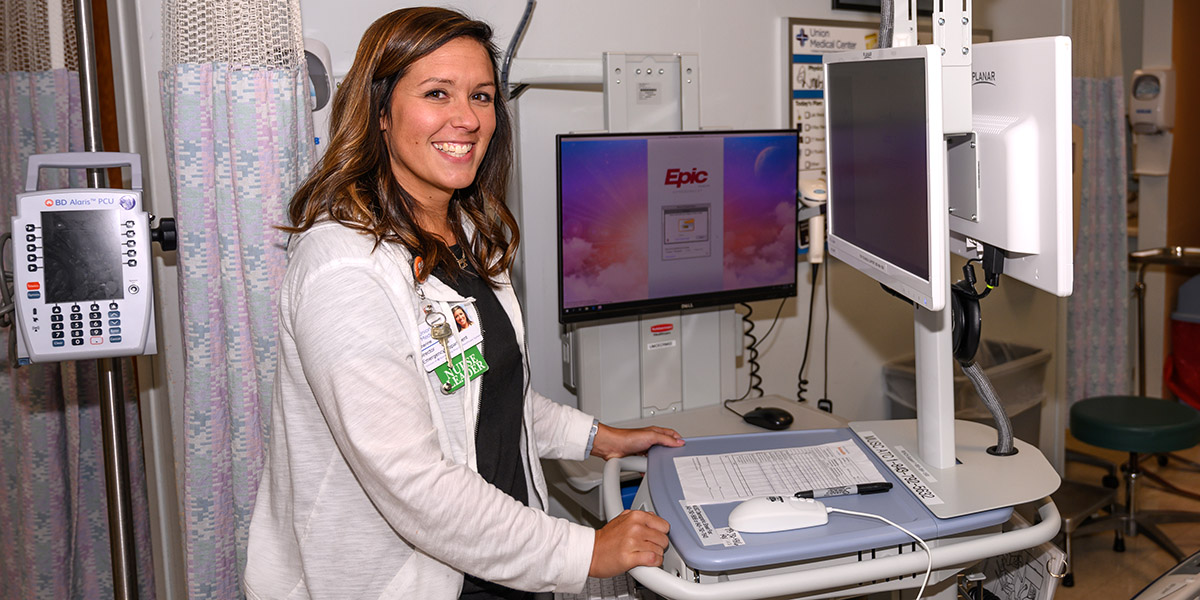
Stroke care within minutes
When someone is having a stroke, every second counts. But when you live in a smaller town that may not have a primary stroke center or a neurologist available 24/7, it can be difficult to get care quickly.
That's when telestroke comes into play at Union Medical Center.
When EMS brings a potential stroke victim into the emergency room at Union Medical Center, a team of nurses evaluates and recommends telestroke services.
With telestroke, a neurologist sees a stroke patient via a video camera, using a secure network, connected with the specialist — this is similar to video chat software on your computer. The nurse in the room assists and is the “hands” of the neurologist on the other end of the screen.
A “clot-busting drug” known as tPA is then administered, if deemed necessary. Patients have less than two hours after the onset of stroke symptoms to be evaluated and receive the tPA medication. This could mean the difference between living a normal life following stroke and paralysis or even death.
It has made a difference in Union.
“Since implementing telestroke, Union Medical Center has administered the tPA medication in a record time of 29 minutes,” said Katie Henderson, RN, Chief Nursing Officer for Union Medical Center.
Care close to home
Aided by a highly trained nurse and the power of telemedicine, neurologists serve a population that is regularly affected by stroke.
Union experiences some of the highest stroke rates in South Carolina, a state ranked fifth in the country for stroke deaths, according to a DHEC report. Obesity, unhealthy diet, physical inactivity, smoking and alcohol consumption increase the risk of stroke, according to the Centers for Disease Control and Prevention.
“When we looked at our county health indicators, we saw there was a need for telestroke services,” said Union Medical Center President Paul Newhouse. “Patients can now be treated close to home in a timely manner.”
In March 2019, Union Medical Center rolled out telestroke services through the South Carolina Telehealth Alliance and the Medical University of South Carolina.
In 2018, 5,427 telestroke consults happened statewide; nearly 1,000 more than 2017, according to the South Carolina Telehealth Alliance.
Spartanburg Medical Center, Cherokee Medical Center and Pelham Medical Center also use telestroke in their emergency departments.
At Union Medical Center, telestroke is just the beginning.
“Union Medical Center is implementing other new telemedicine programs, such as virtual diabetes for outpatient education and telepsychiatry,” Newhouse said. “We look forward to making healthy happen across the community with these new services.”
If you think you are having a stroke, call 911 so you can be taken to the nearest hospital. Learn more about telehealth services throughout Spartanburg Regional Healthcare System.
Know the signs and symptoms of stroke and BE FAST:
- Balance – Having trouble with balance or coordination.
- Eyes – Experiencing blurry or double vision, or sudden loss of vision.
- Face drooping — On side of the face is drooping or numb.
- Arm weakness—One arm is weak or numb. When trying to raise the arm, one will drift downward.
- Speech difficulty — Speech is slurred, or the patient is unable to speak or difficult to understand.
- Time to call 911 — If any of these symptoms present, call EMS to get the patient to the hospital immediately to receive lifesaving medication.










